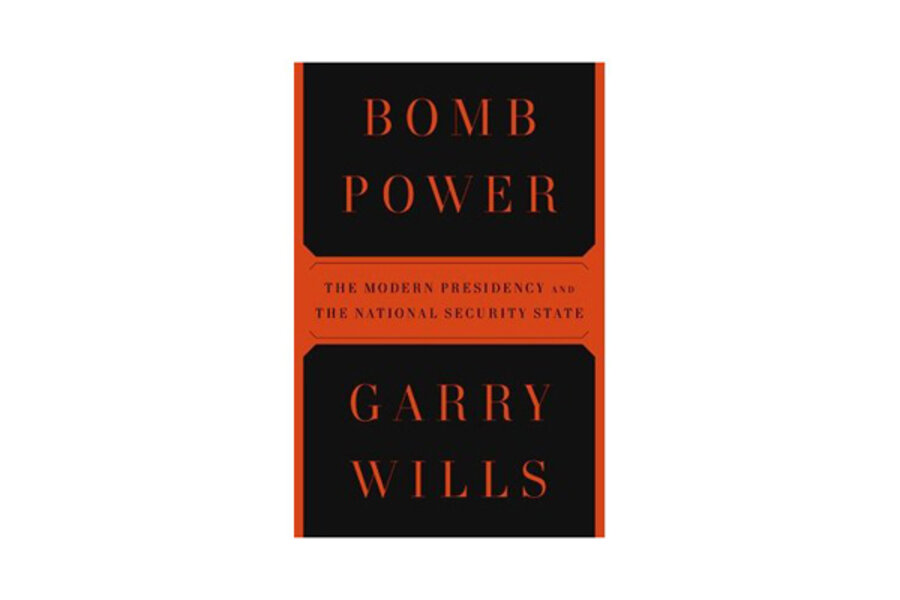Bomb Power
Loading...
Precious few Americans can recall a time not consumed by crisis, whether the Great Depression, World War II, the cold war, oil and financial shocks, or – now – terrorism and global warming. In the modern 24/7 media age, we also ingest a steady diet of lesser emergencies du jour. Most of us grew up with the concept of “The Button” – the fear that our president may be obliged to push it at any moment, in the time it takes to swat a fly, which would destroy our enemies – and very likely ourselves, as well.
In such a relentlessly scary world, it was inevitable that the powers of the US presidency would grow. After all, how many fingers can fit on the top of a button – surely not 535? In his latest book, Bomb Power, Garry Wills argues persuasively that this concentration of power, and the concomitant expansion and secrecy of our national security state, began with the development of the atom and hydrogen bombs, and found its apogee during the administration of George W. Bush and Dick Cheney. Our empire, Wills writes, is unlike previous historical examples and has been shaped by the exigencies of the atom and hydrogen bombs, which were deemed crucial to keeping the Soviet Union at bay: “America ... needed secure places and ships carrying nuclear weapons, and secure regimes providing storage facilities and launching pads for our missiles.”
The idea of war by presidential fiat – which seemed to make sense in a nuclear age – soon would be applied to conventional conflicts and even third-world dust-ups, as well as to tangential areas of government authority. In advancing the power of their office, presidents kept secrets from Congress (even from their own cabinets), created off-the-books budgets for covert operations that included assassinations of foreign leaders, and usurped congressional power where they could. For example, presidents increasingly have taken to approving bills passed by Congress with accompanying “signing statements” that express the executive’s views on, or objections to all or parts of the new law, with the clear implication that he may not enforce it rigorously, or will do so only as he sees fit.
George W. Bush holds the record, of course, objecting to 1,400 sections of bills he signed. Nowadays the executive wants to have the last word.
The Bush-Cheney administration broke new ground when it created military tribunals outside the existing court systems to try enemy combatants. In addition to bestowing the power to declare war on the Congress, the US Constitution gives the legislative branch the authority to establish and manage courts, Wills points out. One wonders: Where are the strict constructionists when we need them? In times of unending crisis, it is the president, not the nattering House and Senate, who steps into the breach and decides whether, for example, the nation should honor its commitment to the Geneva Convention, which Alberto Gonzales, attorney general under George W. Bush, termed “quaint” and “obsolete” when it came to the treatment of prisoners of war.
What Bush had wrought by 2008, according to Wills, began with the Manhattan Project, which Franklin D. Roosevelt set in motion in 1939. The atomic bomb was pursued under the assumptions that Germany was madly working on it, too (its less ambitious program began to peter out in 1942) and that it would be dropped in Europe. But the Nazis were defeated months before the bomb was ready. The Manhattan Project entailed unprecedented secrecy and was conducted way off the books. Vice President Harry Truman, the man who would order the bomb to be used on Japan, only learned of its existence upon Roosevelt’s death.
Presidents ever since, Wills maintains, have reasoned that what was good for making the bomb could be applied to other endeavors, like the Central Intelligence Agency and its covert activities. The author cites an accounting by a New York Times reporter that America has overthrown 114 governments in the past 100 years, among them Iran and Guatemala (Eisenhower), South Vietnam (Kennedy), Grenada (Reagan), Panama and Haiti (George H.W. Bush), and Iraq and Afghanistan (George W. Bush).
The book also documents the way that secrecy required for legitimate national security purposes can metastasize to cover up governmental incompetence or malfeasance. President Nixon kept Americans in the dark about his secret bombing of Cambodia for political, rather than military, reasons; the Cambodians knew all about it the minute the first one exploded.
And what Americans don’t know can hurt them, according to Wills, who argues that President Kennedy was so obsessed with bumping off Fidel Castro after the Bay of Pigs fiasco that secret, bungled assassination attempts induced the Cuban leader to seek missiles from the Soviets to deter America. Wills goes so far as to assert that the Cuban Missile Crisis, and our brush with thermonuclear war, was all Kennedy’s fault.
While his book sometimes seems like a never-ending op-ed piece, Wills knows how to marshal his arguments, usually grounding them in the factual record. The reader also learns delectable tidbits of historical information throughout. For example, by the mid-1950s the United States had already built more bombs than it could ever use, the equivalent in destructive power of 192,000 Hiroshimas. Among other side effects, the effort consumed 6.2 percent of the nation’s electrical power.
David Holahan is a freelance writer based in East Haddam, Conn.






